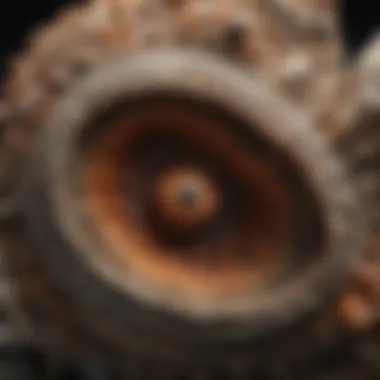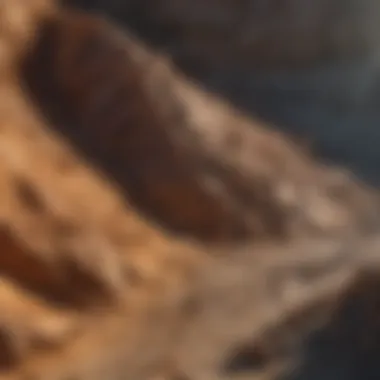Unveiling the Enigmatic World of Fossilized Azoth


Rock and Fossil Identification
Fossilized azoth presents a unique challenge in rock and fossil identification due to its distinct properties and rare occurrence. Unlike typical rocks and fossils, fossilized azoth exhibits intricate crystalline structures and metallic sheen. It requires keen observation skills and specialized knowledge to differentiate it from other geological specimens. Professionals and enthusiasts alike utilize magnifying glasses, geology hammers, and UV light to aid in the identification process, emphasizing the importance of detailed examination.
Geological Insights
Delving into the geological insights of fossilized azoth unveils a fascinating narrative of its formation and historical significance. This rare geological phenomenon is often found in regions rich in ancient mineral deposits, hinting at its unique origins. Scientists speculate on the complex processes involved in the formation of fossilized azoth, linking it to tectonic forces and volcanic activities. The historical significance of this mineral is evident through notable discoveries that have provided valuable insights into Earth's geological past, shaping our understanding of ancient landscapes and mineral evolution.
Introduction to Fossilized Azoth
Defining Azoth in Geology
Historical Significance
Expounding upon the essence of Historical Significance within the realm of Fossilized Azoth illuminates the rich past and cultural reverberations attached to this geological marvel. Unraveling ancient narratives and historical contexts adds depth to our understanding of Fossilized Azoth, portraying its enduring allure and time-honored value. The Historical Significance of Fossilized Azoth is not only pivotal in contextualizing its relevance but also serves as a guiding force in shaping contemporary perspectives and scientific inquiries, making it an indispensable facet of this article.
Modern Interpretation
Amidst the historical tapestry lies the essence of Modern Interpretation, a dynamic lens through which Fossilized Azoth is viewed in the present-day scientific landscape. As technology advances and research methodologies evolve, the Modern Interpretation of Fossilized Azoth embodies the fusion of tradition with innovation, offering fresh insights and perspectives. Embracing Modern Interpretation propels the discourse on Fossilized Azoth forward, bridging the past with the present to chart a course for future investigations with an incisive approach.
Formation of Fossilized Azoth
Chemical Processes
Within the intricate web of Fossilized Azoth's formation lie the Chemical Processes that underpin its metamorphic journey. Chemical interactions, catalytic agents, and transformational mechanisms intricately shape Fossilized Azoth, imbuing it with distinctive properties and characteristics. Delving into the depths of these Chemical Processes unveils the alchemical nature of Fossilized Azoth, revealing a tapestry of molecular events that weave together to create a geological enigma.
Environmental Factors
Amidst the geological milieu, Environmental Factors play a pivotal role in shaping the genesis and preservation of Fossilized Azoth. The interplay of environmental conditions, climatic fluctuations, and geological settings intricately influence the formation and preservation of Fossilized Azoth, bestowing upon it a unique fingerprint of environmental heritage. Understanding the symbiotic relationship between Fossilized Azoth and its environmental milieu offers invaluable insights into the dynamic processes that have sculpted this rare geological phenomenon.
Rare Nature of Fossilized Azoth
Occurrence Rates
The stratigraphic rarity of Fossilized Azoth is a testament to its elusive and captivating nature, with Occurrence Rates serving as a barometer of its scarcity and geological significance. Tracking the prevalence and distribution of Fossilized Azoth across geological formations unveils a mosaic of spatial disparities and temporal anomalies, hinting at the untold stories embedded within its petrified embrace. Exploring Occurrence Rates unearths the enigmatic allure of Fossilized Azoth, beckoning collectors and scientists alike to unravel its geological tapestry.


Unique Geological Conditions
Beneath the surface of Fossilized Azoth lies the Unique Geological Conditions that carve its distinctive narrative and geological identity. From subterranean chambers to lithic landscapes, the interplay of geological forces and tectonic processes creates a stage for Fossilized Azoth to emerge as a geological protagonist of unparalleled rarity. Unveiling the Unique Geological Conditions gives credence to the intricate dance of geological time scales and environmental influences that have sculpted and preserved Fossilized Azoth, offering a glimpse into the geological tapestry that enshrouds this enigmatic fossilized phenomenon.
Characteristics of Fossilized Azoth
In this section, we delve into the crucial aspects that define the essence of fossilized azoth, shedding light on its significance in the broader context of geological studies. Understanding the characteristics of fossilized azoth is paramount to grasping its unique nature and exploring its implications on scientific research and analysis.
Physical Properties
Color Variations
Color variations within fossilized azoth merit meticulous examination due to their role in providing vital clues about the specimen's composition and geological history. The diverse hues encapsulated within fossilized azoth offer a visual spectrum that unravels its chemical makeup and the environmental conditions prevailing during its formation. Vibrant hues or subtle gradients can indicate variations in mineral content, while intense pigmentation may suggest the presence of specific trace elements. Examining these color variations under specialized lighting can unveil hidden intricacies and nuances, enriching our understanding of each specimen's unique journey through time and pressure.
Texture and Hardness
The texture and hardness of fossilized azoth are integral components that underscore its durability and preservation over extended periods. The tactile qualities of fossilized azoth unveil crucial information about the conditions it endured during the fossilization process, showcasing the interplay between pressure, temperature, and mineral infiltration. By assessing the tactile sensation and resistance to abrasion, researchers can glean insights into the specimen's fossilization timeline and related geological events. Furthermore, understanding the hardness of fossilized azoth aids in differentiating it from other geological formations, contributing to precise categorization and scientific analysis.
Chemical Composition
Elemental Makeup
Analyzing the elemental makeup of fossilized azoth offers a glimpse into its intricate composition, presenting a mosaic of minerals and organic remnants preserved within the specimen. By scrutinizing the elemental components present in fossilized azoth, researchers can decipher the depositional environment, geologic processes, and potential sources of mineral impurities. The elemental signature embedded within each specimen serves as a unique identifier, facilitating comparisons with geological databases and aiding in the identification of similar formations across diverse regions.
Isotopic Analysis
Conducting isotopic analysis on fossilized azoth enables researchers to explore its evolutionary trajectory, geological origins, and interaction with surrounding ecosystems. Isotopic data provides invaluable insights into the specimen's journey from deposition to fossilization, shedding light on climatic conditions, nutrient sources, and ecological relationships prevalent during its formation. By unraveling the isotopic signature encoded within fossilized azoth, scientists can reconstruct ancient environments, map out migration patterns, and trace the interplay between flora and fauna throughout geological timeframes.
Structural Features
Internal Patterns
The internal patterns exhibited by fossilized azoth serve as a visual chronicle of its transformation over millennia, encapsulating the intricate interplay between mineral deposition and biological structures. These internal patterns offer a glimpse into the organism's morphological features, growth patterns, and spatial arrangement within the geological matrix. By scrutinizing these internal patterns under high-resolution imaging techniques, researchers can discern hidden details, such as growth rings, structural anomalies, and mineralized tissues, facilitating a comprehensive analysis of the specimen's biological history.
Fossilization Processes


Exploring the fossilization processes influencing fossilized azoth unveils the remarkable journey undertaken by organic matter to metamorphose into enduring geological relics. The fossilization processes encompass a series of intricate steps involving mineral replacement, compaction, and recrystallization, culminating in the transformation of organic remnants into mineralized structures. Understanding these fossilization mechanisms provides crucial insights into the preservation potential of fossilized azoth, delineating the factors that influence its longevity, structural integrity, and susceptibility to environmental alterations.
Significance of Fossilized Azoth in Geological Studies
Fossilized azoth holds a profound significance in geological studies, acting as a crucial window into the Earth's past. This section delves into the pivotal role that fossilized azoth plays in unraveling the mysteries of geological history. By examining the composition and structure of fossilized azoth, scientists can glean invaluable insights into ancient environments, ecosystem dynamics, and evolutionary pathways. The examination of fossilized azoth serves as a foundational pillar for understanding the intricate interplay between geology, paleontology, and environmental changes over geological timescales. This section will expound on the specific elements, benefits, and considerations that underscore the significance of fossilized azoth in geological studies.
Paleontological Insights
Prehistoric Ecosystems
Exploring prehistoric ecosystems through the lens of fossilized azoth provides a unique vantage point into ancient life forms and ecological interactions. The study of fossilized azoth within prehistoric contexts unveils a rich tapestry of biodiversity, offering detailed snapshots of past ecosystems and ecological niches. By analyzing the azoth content within fossils, researchers can discern the environmental conditions, climatic regimes, and biotic associations that characterized ancient habitats. This section will illuminate the key characteristics of prehistoric ecosystems elucidated through the analysis of fossilized azoth, underscoring its significance in reconstructing past environments and understanding evolutionary processes.
Evolutionary Context
Examining the evolutionary context embedded within fossilized azoth fosters a deeper comprehension of species adaptation, diversification, and extinction events across geological timeframes. By scrutinizing the molecular signatures encapsulated in fossilized azoth, scientists can delineate genetic relationships, evolutionary trajectories, and morphological developments in extinct organisms. The integration of evolutionary context within the study of fossilized azoth elucidates the evolutionary drivers, selection pressures, and adaptive strategies that shaped ancient biotas. This section will delve into the unique features of studying evolutionary context through fossilized azoth, shedding light on its advantages in tracing evolutionary lineages and elucidating biological evolution.
Exploring Fossilized Azoth in Collecting Communities
In this section of the article, we delve into the integral role of exploring fossilized azoth within collecting communities, providing a nuanced understanding of its significance beyond geological studies. This exploration is crucial in bridging the gap between scientific research and practical application, offering enthusiasts and collectors a unique perspective on the rare geological specimen.
Collector's Perspectives
Market Demand
Delving into the intricate world of market demand for fossilized azoth, we uncover the underlying dynamics that drive interest and valuation within the collecting community. The essential nature of market demand lies in its ability to shape trends, influence pricing, and reflect the overall appeal of fossilized azoth among collectors. Understanding the fluctuations in market demand provides valuable insights into the evolving landscape of fossil collection, guiding enthusiasts in strategic acquisition and investment decisions.
Rare Finds
The allure of rare finds in the realm of fossilized azoth captivates collectors with the prospect of uncovering unique specimens that stand out amidst the vast expanse of geological treasures. These rare finds serve as coveted additions to collections, imbuing them with unparalleled value and historical significance. By shedding light on the essence of rare finds, collectors are spurred to continue their quest for exceptional pieces, contributing to the enrichment of the fossil collecting community and the preservation of geological heritage.
Conservation and Preservation
Within the domain of exploring fossilized azoth, ethical practices take center stage as guardians of integrity and sustainability in fossil collection. Ethical practices underline the importance of responsible acquisition, preservation, and dissemination of fossilized azoth, ensuring its survival for future generations. By upholding ethical standards, collectors uphold the sanctity of the specimens and foster a culture of respect towards the natural world.
Storage Techniques


Unveiling the vital role of storage techniques in safeguarding fossilized azoth, we illuminate the best practices that aid in preserving the integrity and longevity of these delicate specimens. Effective storage techniques serve as pillars of conservation, shielding fossilized azoth from environmental degradation and physical harm. By embracing suitable storage strategies, collectors safeguard their prized collections, ensuring their continued enjoyment and scientific value.
Educational Outreach
Education opportunities within the context of fossilized azoth empower enthusiasts with knowledge, fostering a deeper appreciation for the geological marvel. Learning opportunities abound in the exploration of fossilized azoth, offering enthusiasts insights into its formation, significance, and impact on earth's history. Embracing educational outreach initiatives opens doors to a wealth of information, nurturing a community of informed collectors committed to the study and preservation of fossilized azoth.
Public Awareness
Elevating public awareness surrounding fossilized azoth not only enriches the knowledge base but also garners support for conservation efforts and scientific endeavors. By shining a spotlight on the importance of fossilized azoth, public awareness drives interest, advocacy, and investment in its preservation. Cultivating a heightened sense of public awareness propels the appreciation of fossilized azoth beyond the confines of collecting communities, paving the way for broader recognition and protection of this geological wonder.
Future Prospects and Research Directions
In this pivotal section of the article uncovering the mysteries of fossilized azoth, we delve into the crucial realm of future prospects and research directions. It is imperative to grasp the importance of continuously advancing our understanding of fossilized azoth to unlock its full potential in geological studies. By focusing on specific elements within this domain, we pave the way for groundbreaking discoveries and scientific advancements.
Technological Innovations
Analytical Tools
Analytical tools play a fundamental role in dissecting the intricate details of fossilized azoth, enabling researchers to unravel its complex composition and characteristics. The utilization of cutting-edge analytical tools such as spectroscopy and microscopy provides a deeper insight into the elemental makeup and isotopic signatures of fossilized azoth. These tools serve as essential instruments in elucidating the formation processes and identifying unique features within the specimens under study. Despite their effectiveness, it is crucial to acknowledge the potential limitations and constraints of certain analytical tools, emphasizing the importance of selecting the most suitable ones tailored to the objectives of the research at hand.
Digital Reconstruction
Digital reconstruction stands at the forefront of technological innovations revolutionizing the study of fossilized azoth. By employing advanced imaging techniques and 3D modeling, digital reconstruction enables the visualization of internal patterns and structural features with unparalleled clarity. This innovative approach not only facilitates a comprehensive understanding of fossilized azoth but also offers a non-destructive method for studying rare specimens. However, it is essential to consider the complexities and intricacies involved in digital reconstruction, ensuring accuracy and consistency in the representation of fossilized azoth for research purposes.
Collaborative Initiatives
Interdisciplinary Partnerships
Collaborative efforts through interdisciplinary partnerships are crucial in expanding the scope and impact of research on fossilized azoth. By bridging expertise from multiple fields such as geology, paleontology, and chemistry, interdisciplinary partnerships enrich the study of fossilized azoth with diverse perspectives and methodologies. The collaborative synergy fosters innovation and capabilities in addressing intricate research questions, ultimately enhancing the quality and depth of scientific investigations. However, challenges may arise in coordinating interdisciplinary efforts, underscoring the need for effective communication and mutual understanding among collaborators.
Global Research Networks
Global research networks play a vital role in establishing a connected platform for sharing knowledge and resources related to fossilized azoth worldwide. Through collaborative initiatives across international borders, researchers can access a vast pool of expertise and data, accelerating the pace of discoveries and insights in the field. The interconnected nature of global research networks facilitates the dissemination of findings and facilitates a cohesive approach towards exploring diverse aspects of fossilized azoth. Nevertheless, the diverse cultural and logistical challenges inherent in global collaborations require careful navigation to ensure equitable and productive outcomes.
Emerging Discoveries
Unearthing New Specimens
The process of unearthing new specimens stands as a fundamental aspect in expanding the database of fossilized azoth and uncovering hidden treasures within geological formations. Whether through field expeditions or excavation projects, the discovery of new specimens provides invaluable opportunities for studying rare variations and enhancing our understanding of fossilized azoth's evolution. The significance of unearthing new specimens lies in the potential revelations they hold about geological history and environmental conditions, contributing to the ever-evolving landscape of scientific knowledge. However, the ethical considerations and conservation practices surrounding specimen collection underscore the delicate balance between exploration and preservation.
Innovative Studies
Innovative studies represent a pivotal frontier in advancing the realm of fossilized azoth research by pushing the boundaries of traditional methodologies and theories. Through groundbreaking approaches such as experimental simulations and cross-disciplinary investigations, innovative studies enable researchers to challenge existing paradigms and explore novel perspectives on fossilized azoth. The key characteristic of innovative studies lies in their capacity to inspire creativity and critical thinking, fostering a culture of scientific inquiry and discovery. However, navigating the uncharted territories of innovative studies necessitates a thorough evaluation of risks and uncertainties, underscoring the importance of methodological rigor and analytical rigor.







